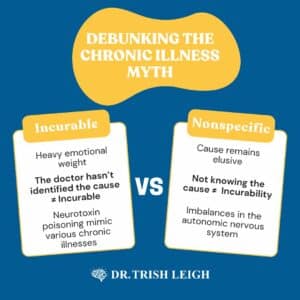Have you ever been told that you have an incurable disease or a chronic illness? Perhaps you’ve received a diagnosis that left you feeling helpless and uncertain about your future. But what if I told you that the label “incurable” doesn’t necessarily mean what you think it does? In this article, we’ll explore the difference between incurable and nonspecific conditions, challenge the framework, and uncover a path to healing.
The Chronic Illness Diagnosis Dilemma
Imagine someone saying to you, “I have this incurable disease.” Your immediate reaction might be sympathy or concern. But let’s pause for a moment. What if I told you that just because a doctor doesn’t know the cause of a condition or how to treat it doesn’t automatically make it incurable? Many so-called “incurable” illnesses fall into the category of nonspecific diagnoses.
Incurable vs. Nonspecific

1. Incurable
- An incurable diagnosis often carries a heavy emotional weight. It implies that there is no hope for improvement or recovery.
- However, consider this: Just because a doctor hasn’t identified the cause or treatment doesn’t mean it’s genuinely incurable.
- Neurotoxin poisoning, for instance, can mimic various chronic illnesses. Once considered incurable, it’s now recognized as a significant factor in many health issues.
2. Nonspecific
- Nonspecific diagnoses are those where the cause remains elusive. Doctors may say, “We don’t know what’s causing it.”
- But here’s the crucial point: Not knowing the cause doesn’t equate to incurability.
- Often, these conditions are fueled by imbalances in the autonomic nervous system. Sympathetic dominance (fight-or-flight response) can wreak havoc, leading to symptoms that defy easy categorization.
The Brain Pattern Connection
At the core of chronic illness lies a brain pattern. When our nervous system is thrown off balance—whether due to physical, mental, or emotional stressors—it becomes hypervigilant; it constantly seeks threats to protect us from. This hyperactivity can manifest as symptoms, even when the cause remains unknown.
In conclusion, the next time you encounter a diagnosis—whether labeled incurable or nonspecific—remember there’s more to the story. Seek answers beyond the surface, challenge assumptions, and embrace the possibility of healing. Your journey toward wellness begins with understanding the brain-body connection and taking empowered steps.
Deep dive with Dr. Trish Leigh and discover the truth behind chronic illness labels.
Embrace the power of your brain-body connection. Take an empowered step towards wellness with a qEEG Brain Map. This advanced tool can help identify underlying root causes your doctor may be missing.

